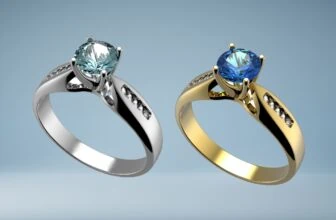
Table of Contents
Yellow gemstones are experiencing a surge in popularity as more and more people turn towards colored gemstone jewelry. From a color psychology point of view, yellow symbolizes many positive concepts, including freshness, happiness, energy, loyalty, and enlightenment. In some cultures, yellow signifies good luck, wealth, and health.
From a fashion perspective, yellow jewelry suits almost every other color. And on the color spectrum, this is the color that is the most attention-getting (hence the reason it’s frequently used for road signs).
With the gemstone world boasting over 100 different types of yellow stones, here’s a list of 25 most popular yellow gemstones that you can add to your collection.
Yellow Gemstones List
1. Yellow Diamond

The yellow diamond is the most common and affordable of all colored diamonds. These stones get their color through traces of nitrogen present during their formation.
Diamonds are known for their brilliance and fire, and these can be seen in yellow diamonds as well. Yellow diamonds are ideal for engagement rings, due to their excellent durability. Although diamonds can tend to be somewhat brittle, they have a hardness of 10 on the Mohs scale, are extremely scratch resistant, and are very easy to maintain.
The best color for yellow diamonds is Fancy Vivid. Most yellow diamonds show tints of a secondary color, which can affect the value of the stone. If the secondary tints are greenish, the value of the stone increases, while brownish tints can drag the price down.
The most expensive and prestigious of all the yellow gemstones, yellow diamond is ideal for you if durability and status are priorities.
2. Yellow Sapphire

Say sapphire and you’re probably thinking of a blue stone but not many people know that sapphires can be found in beautiful yellow hues as well.
Yellow sapphire is second in hardness only to diamonds, with a Mohs ranking of 9. However, they are tougher than diamonds due to their composition and are extremely resistant to breakage and chipping.
The beauty of sapphire is in its color, rather than its play of light. Sapphire comes in a range of yellow tones, from light to intense yellow. This yellow color comes from iron impurities in the stone. The higher the amount of iron present, the more vivid the color and the higher the value of the stone. Sapphires with greenish tints caused by titanium should be avoided as they are not as valuable.
Yellow sapphires are much more affordable than diamonds but have just as beautiful a color. Regular cleaning will keep the stone from getting dirty and cloudy, enabling it to reflect light and sparkle beautifully.
3. Amber

Amber is one of a few organic gemstones and is made of fossilized tree resin. This gemstone has been used for centuries in jewelry, dating back all the way to 13,000 years.
One of Amber’s beautiful characteristics is the many inclusions present in the stone. Some common inclusions include insects and plant matter, and the more interesting the inclusions the higher the price. This is in direct opposition to the general rule that inclusions lower the value of a gemstone.
The flip side of amber is that it is extremely soft, at 2 on the Mohs scale. Amber is also sensitive to chemicals, alcohol, and perfumes and needs extra care.
4. Citrine

Citrine is among the more popularly known yellow gemstones. Called citrine after the French word citron for lemon, this stone is known for its beautiful yellow-brown hue.
With a hardness ranking of 7 on the Mohs scale, citrine is relatively tough and can be worn daily with reasonable care. In case of damage, replacing a citrine will not be too costly as citrine is very affordable.
Citrine is generally high in clarity and doesn’t contain any visible impurities. The stone is highly transparent and comes with a vitreous luster. To enhance its brilliance, citrine is often faceted. Due to its color, citrine has come to symbolize positivity, happiness, and contentment and is popular among crystal healers.
5. Yellow Chrysoberyl

Chrysoberyl is a rare gemstone that exhibits a range of yellow tones from light to vivid. A very durable gemstone, chrysoberyl ranks at 8.5 on the Mohs scale and is also very tough, resisting breakage.
Although the extremely rare and highly valuable alexandrite and cat’s-eye chrysoberyl are members of the same family, yellow chrysoberyl is quite commonly found and not very expensive.
This is a good gemstone for engagement rings, due to its durability. When faceted, it exhibits very good sparkle.
6. Yellow Fire Opal

Opals are generally known for their flashes of color and beautiful milky white or darker body tones. Fire opals are transparent to translucent opals with a dominant red, orange, or yellow tone. Of these three, yellow is the most affordable and common.
Whether faceted or cut smooth, these stones have a beautiful texture and finish. These generally don’t display the flashes of color for which opals are famous.
Fire opal is relatively soft at 5.5 on the Mohs scale. It is not very durable and is susceptible to scratches. It also has poor toughness and can be broken or chipped easily. While not recommended for rings, fire opals make excellent pendants and earrings due to less exposure. It is a subtle, smooth gemstone that is very pretty to look at.
7. Yellow Topaz

The word topaz is said to originate from the Sanskrit word tapas, meaning fire, possibly because of its sparkling golden hues. Although yellow topaz is quite common and affordable, the Imperial Topaz variety, known for its dark orange-yellow color, is rare and expensive.
Yellow topaz ranks at a hard 8 on the Mohs scale. It also has excellent clarity and is rarely found with visible inclusions. With its transparent vitreous sheen, yellow topaz is a brilliant stone when faceted.
8. Yellow Sphene

Sphene might not be a mainstream gemstone, but it boasts brilliance and color to rival any other yellow stone. In fact, a well-faceted yellow sphene is as fiery as a yellow diamond. This is due to the stone’s very high refractive index and ability to play with light.
Yellow sphene is generally found in smaller sizes in nature. These stones often contain impurities and finding eye-clean stones can be difficult. It ranks 7 on the Mohs scale. Yellow sphene is a very rare gemstone and is quite costly. It is a great collector’s item and is sought after.
9. Yellow Tourmaline

Known as the Rainbow Gemstone, tourmaline can be found in every color imaginable. Of these, yellow tourmaline is one of the rarest. It’s difficult to come across yellow tourmalines at brick-and-mortar stores because not many jewelers stock them.
Yellow tourmaline is a very brilliant stone with vivid color. Yellow tourmaline has a hardness rating of 7 to 7.5 on the Mohs scale and with regular maintenance, can last a long time. Most yellow tourmaline contains visible inclusions. Faceting is popular in order to bring out the brilliance of the stone.
10. Yellow Zircon
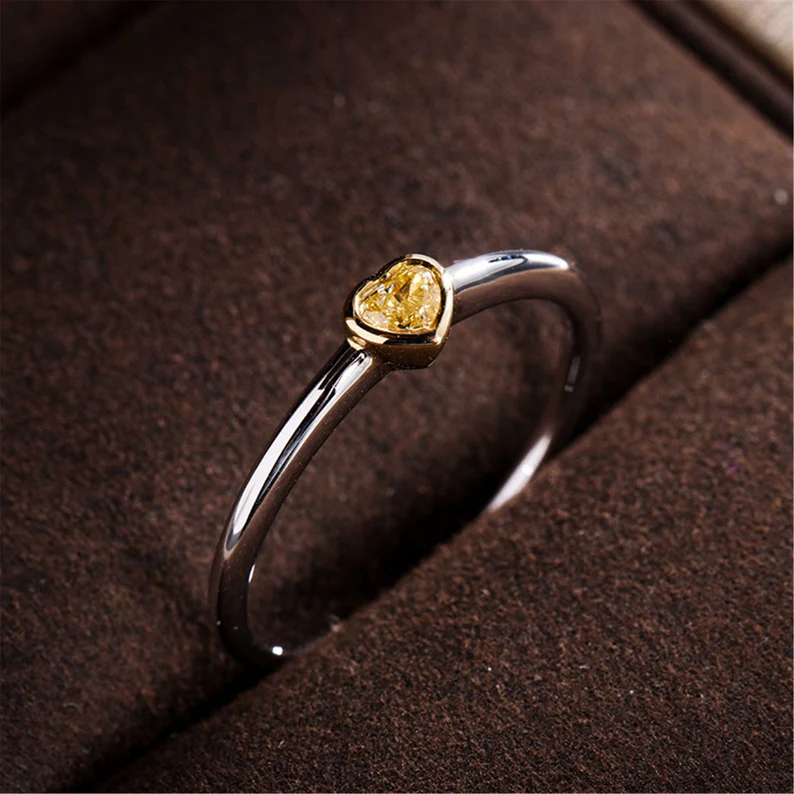
Zircon comes from the Persian word zargun meaning gold color. This is probably because gold is one of the common colors in which zircon is found.
Zircon exhibits a range of yellowish colors from vivid canary yellow to a darker golden-brownish hue. The stone is famous for its brilliance and fire and when faceted into a brilliant cut, the sparkle of this gemstone is beautiful and eye-catching.
Zircon may look very much like a diamond, but it is a much softer stone at 6 to 7.5 on the Mohs scale. It is also a very brittle stone, and is easily damaged or chipped if exposed to hard knocks and rough wear.
As the name zircon sounds very similar to cubic zirconia, the stone has unfortunately often been confused for this cheaper diamond simulant. This has given zircon a bad rep, but for those who know the difference, zircon is a beautiful natural gemstone, comparable to a diamond.
11. Tiger’s Eye
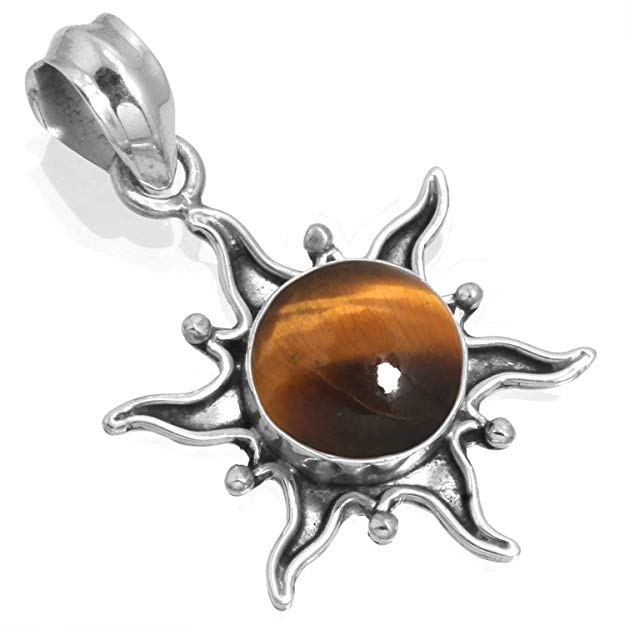
This is a variety of quartz that is very inexpensive. It is famous for its beautiful golden-brown tones and interesting patterns. Many tiger’s eye gemstones also exhibit chatoyancy, known as the cat’s-eye effect, from which it derives its name.
With a hardness rating of 6.5 to 7, the tiger’s eye is good for regular usage. It sometimes displays iridescence and a smooth shiny luster.
It is generally cut in cabochon to enhance the chatoyancy effect and maximize the luster. You can easily find tiger’s-eye to suit any budget.
12. Golden Beryl (Heliodor)

Also called heliodor, derived from the Greek words for ‘gift from the sun’, yellow beryl is a little-known variety from a famous mineral family. Other beryl varieties include the more widely known stones, emerald, morganite, and aquamarine. Yellow beryl is more affordable than these gemstones, although it is made of the same stuff.
Yellow beryl has vivid yellow hues and a hardness rating of 7.5 to 8. It also has very good toughness. Most yellow beryl has very high clarity, with little to no visible inclusions. These fantastic gems are an excellent substitute for the more expensive yellow sapphire and look nearly identical.
13. Yellow Garnet
Although the most popular variety of garnets is dark red, these stones come in every color imaginable. There are a few different yellow garnet varieties, including topazolite, Mali garnet, and andradite.
Yellow garnets are generally eye-clean stones, with high levels of clarity and transparency. You can find them in all shapes and sizes to suit any budget.
Garnets rank 6.5 to 7 on the Mohs scale. They are also the birthstone of January and make excellent gifts for January-born babies.
14. Golden Pearl
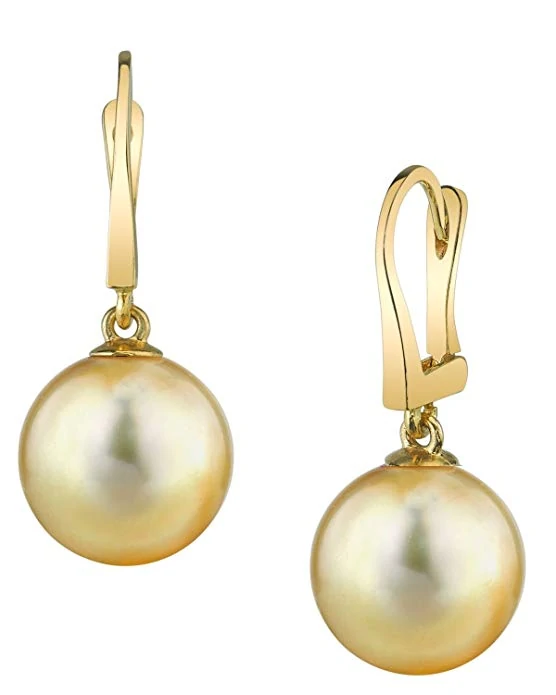
We tend to associate pearls with the color white, but did you know that there are golden pearls too? These are extremely rare and it is estimated that golden pearls account for less than 1% of all pearls produced. Because it is so rare, golden pearls tend to fetch very high prices.
Pearls are an organic gemstone and are very soft at 2.5 on the Mohs scale, similar to amber. They have always had a connection to sophistication and class, and always cycle in and out of fashion. Golden pearls come in cream to gold tones and have a touch of iridescence.
15. Yellow Jade

High-quality yellow jade is very rare and considered by some to be more valuable than green jade. You can find yellow jade in jadeite and nephrite varieties, although nephrite is the most valued.
Yellow jade ranges from translucent to opaque varieties and has a smooth, irresistible texture. The beautiful colors range from pale lemon to dark gold with an oily luster. Yellow jade jewelry is eye-catching and very beautiful.
16. Sphene
Sphene, also known as titanite, is a rare and lesser-known gemstone that is highly sought after for its brilliant yellow-green color and high dispersion and fire. Its refractive index is one of the highest of all gemstones, giving it a remarkable sparkle and a unique and eye-catching appearance. It is typically found in shades of green, yellow, brown, and black, and can have a distinctive pleochroism that causes it to appear in different colors from different angles.
Sphene is mainly found in Sri Lanka and Madagascar, but can also be found in Russia, Canada, and the United States. With a hardness of 5-5.5 on the Mohs scale, sphene is relatively soft and should be handled with care. Despite its relative obscurity, it is a stunning gemstone that is sure to turn heads.
17. Lemon Quartz
Lemon quartz is a type of quartz with a yellow or greenish-yellow color that is popularly used in jewelry. It is durable, brilliant, and versatile, making it a popular choice for a variety of jewelry designs, including necklaces, earrings, bracelets, and rings.
Lemon quartz is typically faceted to maximize its brilliance and enhance its color. It can be cut into a variety of shapes, including round, oval, pear, and cushion. High-quality lemon quartz jewelry can be a beautiful and affordable addition to any jewelry collection, and the gemstone’s purported healing properties make it a unique and meaningful gift for any occasion.
18. Yellow Moonstone
This feldspar mineral has a yellow or golden color with a pearly sheen. It is often used in jewelry due to its unique appearance and relative affordability. It’s a soft gemstone, with a hardness of 6 to 6.5 on the Mohs scale, which makes it vulnerable to scratches and damage.
When used in jewelry, yellow moonstone is typically cut into cabochons or beads to showcase its unique color and sheen. It is often set in silver or gold settings and can be combined with other gemstones such as diamonds, sapphires, or garnets to create intricate and striking designs.
Yellow moonstone is said to have a range of spiritual and healing properties, including the ability to promote inner peace, emotional balance, and mental clarity. It is also believed to enhance intuition and creativity.
19. Yellow Agate
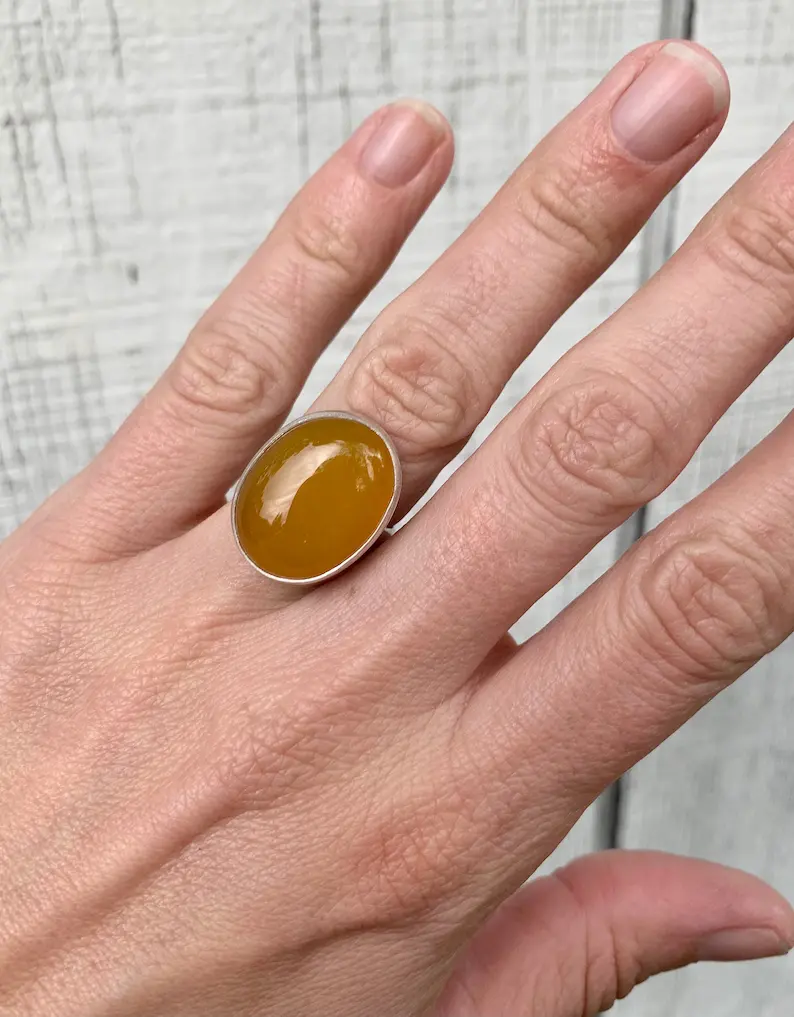
Yellow agate has a hardness of 6.5 to 7 on the Mohs scale, making it a durable gemstone that is suitable for everyday wear. It is found in a variety of locations around the world, including Brazil, Uruguay, and the United States.
This gemstone is typically cut into cabochons or beads to showcase its unique patterns and colors. Yellow agate is often used in combination with other gemstones or metals to create intricate and striking jewelry designs.
In addition to its aesthetic properties, yellow agate is believed to have a range of spiritual and healing properties, including the ability to promote physical and emotional balance, enhance mental clarity, and provide protection from negative energies.
20. Yellow Onyx

A chalcedony mineral, yellow onyx has a yellow to golden color with banded or parallel layers. It’s found in various locations around the world, including Brazil, India, and the United States. This stone is typically cut into cabochons or beads to showcase its unique patterns and colors.
Yellow onyx is often used in combination with other gemstones or metals to create intricate and striking jewelry designs, including rings, earrings, necklaces, and bracelets.
In addition to its aesthetic properties, yellow onyx is believed to have a range of spiritual and healing properties, including the ability to promote physical and emotional strength, enhance focus and self-confidence, and protect against negative energies. Its warm and inviting color makes it a popular choice for those seeking unique and meaningful gemstone jewelry.
21. Scapolite
Scapolite is a relatively rare mineral that belongs to the silicate family. It’s found in various locations around the world, including Canada, Tanzania, Brazil, and Afghanistan. It has a hardness of 5.5 to 6 on the Mohs scale, making it a relatively soft gemstone that requires careful handling.
Scapolite is typically cut into faceted gemstones to maximize its brilliance and enhance its color. In addition to its aesthetic properties, this gemstone is believed to have a range of healing and metaphysical properties, including the ability to promote clarity of thought, enhance creativity and intuition, and increase emotional stability and well-being. Its rarity and unique properties make it a highly prized gemstone among collectors and enthusiasts.
22. Lemon Jade
Lemon jade is a type of jadeite mineral that has a yellow-to-yellow-green color. It is relatively rare and is mainly found in Guatemala and Japan. Lemon jade is often used in jewelry due to its unique color and translucence, often cut into cabochons or beads to showcase its unique patterns and colors.
This gemstone is believed to have a range of spiritual and healing properties, including the ability to promote emotional balance, enhance mental clarity, and attract good luck and prosperity. It is also said to strengthen the immune system and promote physical health.
23. Yellow Spinel
Yellow spinel has a yellow to golden color and is known for its excellent clarity and brilliance. It’s relatively rare and is found in various locations around the world, including Sri Lanka, Burma, and Tanzania.
Yellow spinel has a hardness of 8 on the Mohs scale, making it a durable gemstone that is suitable for everyday wear. It is typically cut into faceted gemstones to maximize its brilliance and enhance its color. It is often used in combination with other gemstones or metals to create unique and striking jewelry designs, including rings, earrings, necklaces, and bracelets.
24. Yellow Chrysoprase
This mineral is typically found in Australia, but can also be found in other regions such as California and Brazil. It’s known for its translucency and vitreous luster and its unique coloration comes from the presence of nickel minerals within the stone. While yellow chrysoprase is a relatively hard mineral with a Mohs hardness of 6 to 7, it can be brittle and should be handled carefully.
In jewelry, yellow chrysoprase is often used as a centerpiece stone due to its vibrant color and unique patterns. In addition to its aesthetic qualities, it’s also believed to possess healing properties. It’s said to promote emotional balance, enhance creativity and imagination, and bring good fortune and prosperity to its wearer.
25. Honey Calcite
Honey calcite is known for its transparency and vitreous to resinous luster. It is often found in sedimentary rocks, such as limestone and dolomite, and can be found in various locations around the world, including Mexico, Brazil, and the United States.
Honey calcite is a relatively soft mineral, with a Mohs hardness of 3, making it easy to carve and shape. It is often used in decorative objects, such as vases and figurines, as well as in jewelry. When used in jewelry, honey calcite is typically cut into cabochons or beads and set in sterling silver or gold to enhance its natural beauty.
Honey calcite is also believed to have a range of healing properties, including the ability to promote clarity of thought, enhance self-confidence, and increase motivation and creativity.
Which Yellow Gemstone Should I Choose?
For Engagement Rings
Yellow gemstones can make unique and beautiful engagement ring options. Here are a few popular yellow gemstones that are ideal for engagement rings and why:
- Yellow Diamond: Yellow diamonds are a popular choice for engagement rings due to their exceptional hardness, durability, and rarity. They are known for their beautiful yellow color, which ranges from light to deep golden hues, and their excellent brilliance and fire.
- Yellow Sapphire: Yellow sapphires are another popular choice for engagement rings. They have a hardness of 9 on the Mohs scale, making them extremely durable and suitable for everyday wear. Yellow sapphires are also known for their beautiful yellow color, which ranges from light to vivid hues, and their exceptional clarity and brilliance.
- Yellow Tourmaline: Yellow tourmaline is a lesser-known but equally beautiful option for engagement rings. It has a hardness of 7 to 7.5 on the Mohs scale, making it durable and suitable for daily wear. It’s known for its unique color, which ranges from pale to deep yellow, and its exceptional clarity and brilliance.
For Costume and Fashion Jewelry
There are several yellow gemstones that are ideal for costume and fashion jewelry due to their affordability, availability, and versatility. Here are a few popular options and why they are well-suited for fashion jewelry:
- Yellow Agate: Yellow agate is a type of chalcedony that is known for its affordability and wide availability. It comes in a range of shades, from pale to deep yellow, and can be used in a variety of fashion jewelry designs, including beaded necklaces, bracelets, and earrings.
- Yellow Jade: Yellow jade is a type of jadeite that is known for its beautiful yellow color and affordability. It is often used in fashion jewelry, particularly in Asian-inspired designs such as chandelier earrings, pendants, and bangles.
- Citrine: Citrine is a type of quartz that is known for its vibrant yellow color and affordability. It is a popular gemstone for fashion jewelry due to its versatility and wide availability. Citrine can be used in a range of jewelry designs, from statement necklaces to delicate rings and earrings.
- Yellow CZ: Yellow cubic zirconia is an affordable and popular option for fashion jewelry. It is known for its bright yellow color and excellent clarity, making it a great choice for statement pieces such as cocktail rings and chandelier earrings.
Soft Yellow Gemstones
Soft yellow gemstones, which are those with a low ranking on the Mohs scale of hardness, are best suited for jewelry that is worn occasionally or for special occasions. They are less durable and more prone to scratches, chips, and other forms of damage than harder gemstones, so they may not be ideal for everyday wear. However, soft yellow gemstones can be beautiful and unique, and they can add a pop of color to a variety of jewelry designs.
Some soft yellow gemstones that are often used in jewelry include:
- Yellow opal
- Amber
- Lemon quartz
- Yellow jasper
- Yellow calcite
To figure out the softness of a gemstone, you can consult the Mohs scale of mineral hardness. This scale ranks minerals from 1 (the softest) to 10 (the hardest) based on their ability to resist scratching. To determine the hardness of a gemstone, you can scratch it with a mineral of known hardness and compare the results.
However, it is important to note that testing a gemstone in this way can damage it, so it should only be done by a professional gemologist. Alternatively, you can consult reference materials or online resources to determine the hardness of a particular gemstone.
Shopping for Yellow Gemstones – What to Consider
There are several factors to consider when buying yellow gemstones:
- Color: Yellow gemstones can come in a range of shades, from pale lemon to deep golden. Consider what shade of yellow you prefer and whether it complements your skin tone and other jewelry.
- Clarity: Some yellow gemstones, such as citrine and yellow sapphire, can be relatively free of inclusions or flaws. However, other gemstones, such as yellow topaz and yellow quartz, may have visible inclusions or cloudiness. Consider the clarity of the gemstone you are interested in and how it will affect the overall appearance of your jewelry.
- Cut: The cut of a gemstone can affect its brilliance and overall appeal. Consider whether you prefer a faceted or cabochon cut and whether the gemstone has been cut and polished to bring out its best qualities.
- Hardness: Some yellow gemstones, such as yellow diamonds and yellow sapphires, are very hard and durable. Others, such as yellow opal and yellow calcite, are softer and may be more prone to damage. Consider how the gemstone’s hardness will affect its longevity and how you plan to wear your jewelry.
- Price: Yellow gemstones can vary in price depending on their rarity, quality, and size. Consider your budget and how much you are willing to spend on a yellow gemstone.
- Source: Some yellow gemstones, such as citrine and yellow topaz, are readily available and affordable. Others, such as yellow diamonds and yellow sapphires, may be rare and more valuable. Consider the source of the gemstone and whether it has been ethically sourced.
FAQs about Yellow Gemstones
What is the most precious yellow stone?
The most precious yellow stone is the yellow diamond, which is highly valued for its rarity and intense color.
What do yellow gemstones symbolize?
Yellow gemstones are often associated with warmth, joy, and happiness, and can symbolize optimism, confidence, and creativity.
What yellow stone attracts wealth?
Citrine is often associated with attracting wealth and abundance, and is sometimes referred to as the “merchant’s stone.”
What is the yellow stone for success?
Yellow sapphire is often associated with success, prosperity, and good fortune, and is believed to bring positive energy and opportunities.
What precious stone is bright yellow?
Yellow diamonds can be found in bright yellow hues, ranging from pale yellow to vivid canary yellow, and are highly prized.
Wrapping Up
Yellow gemstones can add a vibrant and cheerful touch to any jewelry piece. From the fiery brilliance of yellow diamonds to the warm glow of yellow sapphires and citrines, there is a wide range of yellow gemstones to choose from.
Whether you’re looking for an engagement ring, a statement necklace, or a pair of earrings, there is a yellow gemstone out there that can help you express your unique style and personality. So go ahead and add a touch of sunshine to your jewelry collection with a beautiful yellow gemstone today!




